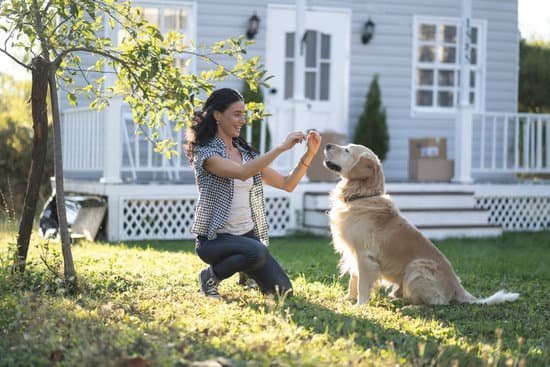Training dogs to use a litter box may seem like an unconventional idea, but it is one that has gained attention and sparked interest among dog owners. Traditionally, house training dogs involved teaching them to relieve themselves outdoors or on designated puppy pads inside the house. However, the concept of using a litter box for dogs offers an alternative solution that can be especially beneficial for those living in apartments or with limited outdoor access.
The convenience of having a dog that can use a litter box cannot be overstated. It eliminates the need for constant trips outside, particularly during unfavorable weather conditions or late at night. Moreover, it can provide a sense of security for owners who worry about leaving their dogs alone indoors for extended periods.
While many may assume that only small breeds or toy-sized dogs are suitable candidates for litter box training, this is not necessarily true. It depends on various factors such as breed, age, and previous training methods. Some larger breeds have successfully adapted to using litter boxes with proper guidance and consistency.
In this article, we will delve into the possibility of training dogs to use a litter box. We will explore the benefits of litter box training, analyze its feasibility across different dog breeds, and discuss the steps involved in successfully teaching a dog to use a litter box.
Additionally, we will address common challenges that may arise during the process and provide strategies for overcoming them. By the end of this article, you will have a comprehensive understanding of whether dogs can be trained to use a litter box and how to go about achieving success in this endeavor.
Understanding the Benefits of Litter Box Training for Dogs
Introduction:
House training dogs is a necessary and often challenging task for pet owners. Traditional methods usually involve teaching dogs to go outside to relieve themselves. However, there is an alternative approach that has gained popularity in recent years – litter box training for dogs. This section will explore the benefits of litter box training and why it may be a suitable option for certain dog owners.
Highlighting Convenience:
One of the key benefits of litter box training for dogs is the convenience it offers to both the dog and their owner. Unlike traditional house training methods where dogs need to be taken outside multiple times a day, a litter box provides an indoor solution for potty needs.
This is particularly beneficial for those living in apartments or high-rise buildings with limited outdoor access. Litter boxes can be easily placed indoors, making it more practical and time-saving for owners who may have busy schedules or mobility issues.
Ideal for Apartment Living:
For individuals residing in apartments, litter box training can be a game-changer. Taking a dog outside every time they need to go potty might not always be feasible if there are long distances involved or if weather conditions are unfavorable.
Litter boxes offer a convenient indoor option that eliminates the need for hurried trips down several flights of stairs or long walks in unpredictable weather. Additionally, if an owner works long hours or has physical limitations that prevent them from taking their dog outside frequently, a litter box provides a reliable backup solution.
Cost-Effective Solution:
Another advantage of litter box training is its cost-effectiveness. While traditional house-training methods may require investing in puppy pads or hiring professional dog walkers, litter boxes provide a one-time investment that lasts over time. Owners also save money on potential damage caused by accidents on carpets or flooring surfaces.
Addressing critiques:
While some critics argue that using a litter box might confuse dogs about where they should relieve themselves, many pet owners have successfully trained their dogs to use this method without any issues. As with any training method, consistency and positive reinforcement play crucial roles in the success of litter box training. Understanding each individual dog’s needs, preferences, and limitations will greatly contribute to a successful outcome.
Analyzing the Feasibility of Training Dogs to Use a Litter Box
When it comes to training dogs to use a litter box, one question that often arises is whether all dogs can be trained to do so. While many dogs can indeed be successfully litter box trained, there are certain factors that may affect the feasibility and effectiveness of this method.
Breed is one factor that can influence the success of litter box training. Some dog breeds naturally have a stronger instinct to eliminate outdoors and may find it more challenging to adapt to using a litter box. Additionally, certain breeds, such as smaller toy breeds, may have difficulty accessing or using larger-sized litter boxes.
Age also plays a role in the feasibility of litter box training. Generally, puppies have an easier time adapting to new behaviors and routines compared to older dogs. It is recommended to start litter box training at a young age when puppies are more receptive and adaptable.
Previous training methods and experiences can also impact the success of litter box training. Dogs who have been consistently trained to eliminate outdoors may initially struggle with the transition to using a litter box indoors. However, with patience and consistency, most dogs can learn new habits and adapt to using a designated area for elimination.
To determine the feasibility of training your dog to use a litter box, it is important to consider their individual characteristics such as breed, age, and previous training experiences. Every dog is unique, so while some dogs may take readily to litter box training, others may require more time and effort before they fully embrace this method. With proper guidance and patience, however, many dogs can successfully be trained to use a litter box.
| Factors | Impact on Feasibility |
|---|---|
| Breed | Some breeds may find it more challenging or less natural to use a litter box |
| Age | Younger dogs tend to be more adaptable and receptive to new training methods |
| Previous Training | Dogs with prior experience of eliminating outdoors may need more time and consistency to adjust to using a litter box |
Selecting the Right Litter Box for Your Dog’s Training
Types of Litter Boxes
When it comes to litter box training for dogs, selecting the right litter box is crucial for their success. There are various types of litter boxes available in the market that cater to different dog sizes and preferences. The three main types of litter boxes commonly used for dogs include traditional litter boxes, grass-like litter boxes, and disposable litter boxes.
Traditional litter boxes are similar to those used by cats, with low sides and a flat bottom. These can be easily found in pet stores and online. Grass-like litter boxes, on the other hand, are designed to mimic outdoor environments for dogs who may be more accustomed to eliminating on grass. These often come with artificial or real grass mats that provide a more natural feel for your dog while they do their business.
Disposable litter boxes offer convenience and ease of cleaning. They usually come in a set with a tray lined with disposable pads or absorbent materials. These are ideal for pet owners who travel frequently or have limited time for regular maintenance.
Tips for Choosing the Right Litter Box
When selecting a litter box for your dog’s training, there are several factors to consider. First and foremost, you need to take into account the size of your dog. For smaller breeds or puppies, a small-sized litter box would suffice, while larger dogs may require a larger box to accommodate their size comfortably.
Additionally, it’s important to consider your dog’s preferences when choosing a litter box. Some dogs may prefer traditional boxes while others may respond better to grass-like options. Observe your dog’s behavior during potty breaks, as this can give you an indication of their preferences.
Lastly, ease of cleaning should also be a factor in your decision-making process. Look for litter boxes that have smooth surfaces and removable parts that can be easily washed or replaced when needed. The easier it is to maintain cleanliness in the litter box area, the more successful your dog’s litter box training will be.
Remember that finding the right litter box for your dog may require some trial and error. It’s important to be flexible and willing to make adjustments as you go along in the training process. By selecting a suitable litter box, you provide your dog with a comfortable and conducive environment for successful training.
Essential Steps for Successfully Training Dogs to Use a Litter Box
Litter box training can be a convenient solution for dog owners, especially those living in apartments or facing limited outdoor access. While it may seem challenging at first, with consistency and patience, most dogs can be successfully trained to use a litter box. Here are some essential steps to follow when training your dog to use a litter box.
- Choose the right litter box: There are various types of litter boxes available in the market, including traditional ones, grass-like options, and disposable alternatives. Consider your dog’s size, preferences, and ease of cleaning when selecting the appropriate litter box. Experiment with different types to see which one works best for your dog.
- Introduce the litter box gradually: Start by placing the litter box in an easily accessible area where your dog spends most of its time. Allow your dog to explore and sniff around the litter box without any pressure to use it. This will help them become familiar with it and associate it with positive experiences.
- Encourage and reward desired behavior: When you catch your dog showing interest in or using the litter box, praise them enthusiastically and offer treats as rewards. Positive reinforcement is key during the training process. Avoid scolding or punishing your dog for accidents outside the litter box as this can create anxiety or fear.
- Establish a routine: Consistency is crucial when training dogs to use a litter box. Take your dog to the designated area at regular intervals throughout the day, especially after meals or playtime. Create a schedule that aligns with your dog’s natural elimination patterns to increase the chances of success.
- Deal with setbacks calmly: Accidents may happen during the training process, but it’s important not to get discouraged or lose patience. Clean up accidents promptly using pet-safe cleaners that eliminate odor effectively. Avoid ammonia-based products as they can mimic urine scent and encourage future accidents in the same spot.
Training a dog to use a litter box requires time, effort, and understanding. While some dogs may pick up the concept quickly, others might take longer to adjust. Stay consistent with the training process and seek professional guidance if needed. With dedication and persistence, you can successfully train your dog to use a litter box.
| Step | Description |
|---|---|
| Choose the Right Litter Box | Consider the type of litter box that suits your dog’s size and cleaning preferences. |
| Introduce the litter box gradually | Familiarize your dog with the litter box by allowing them to explore and associate it with positive experiences. |
| Encourage and reward desired behavior | Praise your dog and offer treats when they show interest in or use the litter box correctly. |
Overcoming Challenges and Common Issues in Litter Box Training
Litter box training for dogs can come with its fair share of challenges and common issues. However, with the right approach and strategies, these obstacles can be overcome, leading to successful training and a dog that consistently uses the litter box. Here are some common problems that may arise during the training process and troubleshooting strategies to help you overcome them:
- Accidents: It is not uncommon for dogs to have accidents outside of the litter box during the initial stages of training. To address this issue, it’s essential to supervise your dog closely and provide frequent opportunities for them to use the litter box.
If an accident does occur, avoid punishing your dog as it may create fear or confusion. Instead, clean up the mess thoroughly using an enzymatic cleaner to eliminate any lingering odor that may attract your dog back to that spot. - Refusal to use the litter box: Some dogs may initially refuse to use the litter box due to unfamiliarity or preference for other surfaces. In such cases, try enticing your dog by placing their favorite treats or toys near or inside the litter box.
Gradually move these rewards closer into the litter as your dog becomes more comfortable with using it. Additionally, make sure that the litter box is easily accessible and placed in a quiet area away from distractions or high foot traffic. - Confusion: Dogs may sometimes become confused about where they should eliminate, especially if they have been trained through different methods previously. If confusion arises, it’s important to be consistent with your training approach and avoid switching between methods. Stick with one method consistently until your dog understands where they should go potty.
By addressing these challenges and implementing appropriate troubleshooting strategies, you can improve your dog’s success in litter box training. With patience, consistency, and positive reinforcement, you’ll be on your way to having a well-trained dog that reliably uses a litter box.
- Supervise closely and provide frequent opportunities for your dog to use the litter box.
- Clean up accidents thoroughly with an enzymatic cleaner to prevent repeat incidents.
- Use enticing treats or toys to motivate your dog to use the litter box.
- Ensure easy accessibility and minimal distractions in the litter box area.
- Be consistent with your training approach and avoid switching between methods.
- Patience and positive reinforcement are key to successful litter box training.
Maintaining Hygiene and Ensuring Cleanliness in the Litter Box Area
One important aspect of litter box training for dogs is maintaining hygiene and ensuring cleanliness in the litter box area. This is not only crucial for the well-being of your dog but also for creating a hygienic environment in your home. Here are some tips to help you maintain a clean litter box area:
- Regular Cleaning: It is essential to clean the litter box regularly to prevent odors and keep it sanitary. Scoop out solid waste daily and replace soiled litter every few days or as needed. Empty and thoroughly clean the entire litter box at least once a week using mild soap and water.
- Choose the Right Litter: The type of litter you choose can impact how easy it is to maintain cleanliness in the litter box area. Opt for clumping litter, as it makes it easier to remove both urine and solid waste. Additionally, consider using scented or odor-control litters that can help neutralize any unpleasant odors.
- Provide Multiple Litter Boxes: If you have multiple dogs or live in a multi-level home, it may be beneficial to provide multiple litter boxes. This not only prevents overcrowding but also gives each dog their own designated place to eliminate, reducing the likelihood of accidents outside the box.
- Location Matters: Choose an appropriate location for the litter box area that is accessible to your dog yet will not create any inconvenience for you or other family members. Ideally, place it in an easily accessible but relatively quiet and private area of your home.
- Monitor and Address Accidents: While accidents may happen during the training process, it’s important to promptly address them to avoid reinforcing bad habits. Clean any accidents thoroughly with an enzymatic cleaner designed for pet messes, as this helps eliminate any residual odor that may attract your dog back to that spot.
By following these guidelines and implementing good practices, you can maintain a clean and hygienic litter box area for your dog. This not only promotes their health and well-being but also contributes to the success of litter box training by providing an inviting and pleasant environment for them to use.
Comparing Litter Box Training to Other House-Training Methods
When it comes to house-training dogs, the traditional methods of using puppy pads or teaching them to signal their need to go outside are widely known. However, an alternative method that is gaining popularity is litter box training for dogs. In this section, we will compare and contrast litter box training with these other house-training methods to help you determine which approach may be more suitable for your dog.
One advantage of litter box training is the convenience it offers. Unlike puppy pads that need to be changed regularly, a litter box can contain the mess and odors more effectively. This can be particularly beneficial for individuals living in apartments or houses without easy access to outdoor spaces. Additionally, if unpredictable weather conditions make it difficult for your dog to go outside, having a litter box can provide a suitable solution.
Another factor to consider when comparing house-training methods is suitability for different dog breeds. Litter box training tends to be more successful with smaller dog breeds or those with lower energy levels who are less likely to disturb the contents of the box. On the other hand, larger or highly active dogs may have difficulty adapting to a small space like a litter box and prefer the freedom of going outside.
Age and previous training experiences also play a role in determining the feasibility of litter box training. Puppies who have not yet developed strong preferences for elimination spots may adapt quickly to using a litter box. However, older dogs who have been trained through traditional methods may find it more challenging to adjust their behavior. It is important to consider these factors when deciding whether or not litter box training is suitable for your dog.
And Finally, Can You Really Train Dogs to Use a Litter Box?
When it comes to the question of whether dogs can be trained to use a litter box, the answer is yes, it is indeed possible. Throughout this article, we have explored the benefits and feasibility of litter box training, discussed the selection process for the right litter box, provided step-by-step instructions for training, and addressed common issues that may arise during the process.
Now, let’s conclude our exploration by summarizing the key points discussed and providing an answer to the initial question.
Litter box training offers convenience and flexibility for dog owners, especially those living in apartments or with limited outdoor access. It provides an alternative solution to house training that allows dogs to relieve themselves indoors without creating a mess. Additionally, litter box training can be beneficial for certain situations where traditional house-training methods may not be suitable or advantageous.
The success of litter box training depends on various factors such as breed, age, and previous training methods. While some dogs may take naturally to using a litter box, others may require more patience and consistency in their training. It is important to understand that not all dogs will adapt to litter box training in the same way, but with time and proper guidance, most dogs can learn this new behavior.
To successfully train a dog to use a litter box, it is essential to select the appropriate type of litter box based on size, preferences, and ease of cleaning. A thorough understanding of the step-by-step process is also crucial along with consistent reinforcement and positive encouragement throughout the training period. Although challenges may arise during this process such as accidents or refusal to use the litter box, they can generally be overcome with troubleshooting strategies.
Conclusion
In conclusion, while litter box training may not be suitable for all dogs, it is definitely a possibility worth considering for many pet owners. The benefits of having a dog that can use a litter box are undeniable, particularly in situations where outdoor access is limited or when living in apartments. It offers convenience and eliminates the need for constant supervision or reliance on traditional house training methods.
Before embarking on litter box training, it is important to understand that success may vary depending on factors such as breed, age, and previous training methods. Not all dogs will take to the litter box easily, but with patience, consistency, and positive reinforcement, most dogs can be trained to use it effectively.
When choosing a litter box, there are various options available in the market to suit different preferences and sizes of dogs. It is important to consider the ease of cleaning as well as the dog’s own preferences when selecting the most suitable option.
Throughout the training process, there may be challenges and setbacks along the way. However, by anticipating common issues and implementing appropriate troubleshooting strategies, these obstacles can be overcome. Regular maintenance and hygiene practices are also crucial in ensuring successful litter box training.
In comparison to traditional house-training methods such as using puppy pads or teaching dogs to signal their need to go outside, litter box training offers unique advantages in certain situations. It provides an indoor solution for dogs without abundant outdoor access or during harsh weather conditions.
So, can you really train dogs to use a litter box? The answer is yes, but with some considerations. Litter box training is a feasible option for many dogs and can offer convenience for both pet owners and their furry companions. By following step-by-step instructions and addressing common challenges with patience and persistence, most dogs can successfully adapt to using a litter box as part of their house-training routine.
Frequently Asked Questions
How do I get my dog to use the litter box?
Getting a dog to use a litter box can be challenging as it goes against their natural instincts to eliminate outside. However, it is possible to train some dogs to use a litter box with patience and consistency. The first step is to select an appropriate litter box that is large enough for your dog to comfortably turn around in. It’s important to place the litter box in a convenient location that is easily accessible for your dog.
Next, introduce your dog to the litter box by placing them inside while praising and rewarding them for exploring it. Gradually start transitioning your dog’s bathroom routine indoors by encouraging them to use the litter box after meals or when they indicate the need to go outside. Consistently reward and praise your dog each time they successfully use the litter box, gradually reducing rewards over time.
Can you train a dog to use a litter box outside?
While it is theoretically possible to train a dog to use a litter box outside, it may not be advisable for several reasons. Dogs are naturally inclined to relieve themselves outdoors, so teaching them to use a litter box outside might create confusion and inconsistency in their toilet habits. Additionally, maintaining cleanliness could be more challenging compared to having them eliminate directly on grass or other outdoor surfaces.
Furthermore, dogs tend to have larger elimination needs than cats, which means that cleaning and replacing the litter more frequently may be necessary. Therefore, although not impossible, training a dog to use an outdoor litter box might present more difficulties and inconsistencies than training them for outdoor relief.
Why don’t dogs use a litter box?
Dogs do not typically use a litter box because they have evolved as creatures who prefer eliminating outdoors in open spaces or on natural surfaces like grass or soil. Unlike cats who instinctively dig and cover their waste as part of their natural feline behavior, dogs have different instincts when it comes to toileting habits. They rely on their sense of smell and marking behaviors through urine and feces outdoors as a form of communication with other dogs in their territory.
Additionally, dogs naturally prefer larger areas to move around and eliminate, whereas litter boxes are often limited in size. Overall, the lack of natural inclination and instincts for using a litter box is why dogs generally do not utilize this method of elimination.

Welcome to the blog! I am a professional dog trainer and have been working with dogs for many years. In this blog, I will be discussing various topics related to dog training, including tips, tricks, and advice. I hope you find this information helpful and informative. Thanks for reading!





